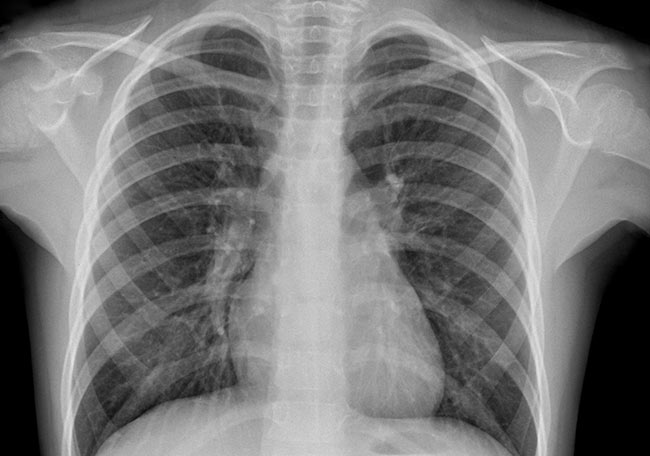Intervenciones para reducir imágenes y estudios innecesarios en pediatría

1. Scott IA, Duckett SJ. In search of professional consensus in defining and reducing low-value care. Med J Aust. 2015; 203(4): 179–181
2. Levinson W, Kallewaard M, Bhatia RS, Wolfson D, Shortt S, Kerr EA; Choosing Wisely International Working Group. ‘Choosing Wisely’: a growing international campaign. BMJ Qual Saf. 2015; 24(2):167–174
3. Lallemand NC. Health policy brief: Reducing waste in health care. December 13, 2012. Available at: https://www.healthaffairs.org/do/10. 1377/hpb20121213.959735/full/
4. Hong AS, Ross-Degnan D, Zhang F, Wharam JF. Small decline in low-value back imaging associated with the ‘Choosing Wisely’ campaign, 2012-14. Health Aff (Millwood). 2017; 36(4): 671–679
5. Brehaut JC, Colquhoun HL, Eva KW, et al. Practice feedback interventions: 15 suggestions for optimizing effectiveness. Ann Intern Med. 2016; 164(6):435–441
6. Ivers N, Jamtvedt G, Flottorp S, et al. Audit and feedback: effects on professional practice and healthcare outcomes. Cochrane Database Syst Rev. 2012;(6):CD000259
7. Moher D, Liberati A, Tetzlaff J, Altman DG; PRISMA Group. Preferred reporting items for systematic reviews and meta-analyses: the PRISMA statement. BMJ. 2009; 339:b2535
8. National Institute for Health and Care Excellence. Cost saving and resource planning. Available at: https://www. nice.org.uk/savingsAndProductivity/ collection?page=1&pageSize=2000& type=Do+not+do&published. Accessed November 6, 2017
9. Kobewka DM, Ronksley PE, McKay JA, Forster AJ, van Walraven C. Influence of educational, audit and feedback, system based, and incentive and penalty interventions to reduce laboratory test utilization: a systematic review. Clin Chem Lab Med. 2015; 53(2):157–183
10. Thomas J, Brunton J, Graziosi S. EPPIReviewer 4: Software for Research Synthesis. EPPI-Centre Software. London, United Kingdom: Social Science Research Unit, UCL Institute of Education; 2010
11. Effective Practice and Organisation of Care. Suggested risk of bias criteria for EPOC reviews. Available at: http://epoc.cochrane.org/sites/ epoc.cochrane.org/files/public/ uploads/Resources-for-authors2017/ suggested_risk_of_bias_criteria_for_ epoc_reviews.pdf
12. Oxford Centre for Evidence-Based Medicine. Oxford Centre for Evidence Based Medicine 2011 levels of evidence. Available at: http://www. cebm.net/wp-content/uploads/2014/ 06/CEBM-Levels-of-Evidence-2.1.pdf. Accessed November 6, 2017
13. South M. Radiological investigations following urinary tract infection: changes in Australian practice. Arch Dis Child. 2009; 94(12):927–930
14. Boutis K, Grootendorst P, Willan A, et al. Effect of the low risk ankle rule on the frequency of radiography in children with ankle injuries. CMAJ. 2013; 185(15):E731–E738
15. Higgins JC, Kiser WR, McClenathan S, Tynan NL. Influence of an interventional program on resource use and cost in pediatric asthma. Am J Manag Care. 1998; 4(10):1465–1469
16. Jerardi KE, Elkeeb D, Weiser J, Brinkman WB. Rapid implementation of evidence-based guidelines for imaging after first urinary tract infection. Pediatrics. 2013; 132(3). Available at: www.pediatrics.org/cgi/content/full/ 132/3/e749
17. Kalani A, Gilroy M, Del Pozo J, Orr T, Lawson M. Reduced healthcare utilization achieved by a multidisciplinary behavioral intervention for adolescents with irritable bowel syndrome (IBS): four-year healthcare utilization data including diagnostic imaging studies, number, and nature of healthcare visits. Am J Gastroenterol. 2014; 109(suppl 2):S544–S593
18. Kalani A, Green A, Crebassa L, et al. A simple intervention program markedly decreases resource utilization for adolescents with irritable bowel syndrome (IBS). Am J Gastroenterol. 2012; 107(Suppl 1):S700–S701
19. Kalani A, Griem A, Crebassa L, Mow W, Lawson MJ. Recognizing the “crisis year” in adolescent irritable bowel syndrome (IBS): an effective program that can reduce healthcare utilization. Gastroenterol. 2013; 144 (5 suppl 1):S93–S94
20. Chien AT, Ganeshan S, Schuster MA, et al. The effect of price information on the ordering of images and procedures. Pediatrics. 2017; 139(2):e20161507
21. Arlen AM, Merriman LS, Kirsch JM, et al. Early effect of American Academy of Pediatrics urinary tract infection guidelines on radiographic imaging and diagnosis of vesicoureteral reflux in the emergency room setting. J Urol. 2015; 193(suppl 5):1760–1765
22. Graf WD, Kayyali HR, Alexander JJ, Simon SD, Morriss MC. Neuroimaging use trends in non acute pediatric headache before and after clinical practice parameters. Pediatrics. 2008; 122(5). Available at: www. pediatrics.org/cgi/content/full/122/5/ e1001
23. Judkins A, Pascoe E, Payne D. Management of urinary tract infection in a tertiary children’s hospital before and after publication of the NICE guidelines. Arch Dis Child. 2013; 98(7):521–525 24. Akenroye AT, Stack AM. The development and evaluation of an evidence-based guideline programme to improve care in a paediatric emergency department. Emerg Med J. 2016; 33(2):109–117
25. Kwon H, Jung JY. Effectiveness of a radiation reduction campaign targeting children with gastrointestinal symptoms in a pediatric emergency department. Medicine (Baltimore). 2017; 96(3):e5907
26. Mittal V, Darnell C, Walsh B, et al. Inpatient bronchiolitis guideline implementation and resource utilization. Pediatrics. 2014; 133(3). Available at: www.pediatrics.org/cgi/ content/full/133/3/e730
27. Nigrovic LE, Stack AM, Mannix RC, et al. Quality improvement effort to reduce cranial CTs for children with minor blunt head trauma. Pediatrics. 2015; 136(1). Available at: www. pediatrics.org/cgi/content/full/136/1/ e227
28. Ralston SL, Garber MD, Rice-Conboy E, et al; Value in Inpatient Pediatrics Network Quality Collaborative for Improving Hospital Compliance with AAP Bronchiolitis Guideline (BQIP). A multicenter collaborative to reduce unnecessary care in inpatient bronchiolitis. Pediatrics. 2016; 137(1):e20150851
29. Shah SR, Sinclair KA, Theut SB, Johnson KM, Holcomb GW III, St Peter SD. Computed tomography utilization for the diagnosis of acute appendicitis in children decreases with a diagnostic algorithm. Ann Surg. 2016; 264(3):474–481
30. Goldberg J, McClaine RJ, Cook B, et al. Use of a mild traumatic brain injury guideline to reduce inpatient hospital imaging and charges. J Pediatr Surg. 2011; 46(9):1777–1783
31. Buckmaster A, Boon R. Reduce the rads: a quality assurance project on reducing unnecessary chest x-rays in children with asthma. J Paediatr Child Health. 2005; 41(3):107–111 32. Depinet H, von Allmen D, Towbin A, Hornung R, Ho M, Alessandrini E. Risk stratification to decrease unnecessary diagnostic imaging for acute appendicitis. Pediatrics. 2016; 138(3):e20154031
33. Gildenhuys J, Lee M, Isbister GK. Does implementation of a paediatric asthma clinical practice guideline worksheet change clinical practice? Int J Emerg Med. 2009; 2(1):33–39
34. Russell WS, Schuh AM, Hill JG, et al. Clinical practice guidelines for pediatric appendicitis evaluation can decrease computed tomography utilization while maintaining diagnostic accuracy. Pediatr Emerg Care. 2013; 29(5):568–573
35. Browning JG, Reed MJ, Wilkinson AG, Beattie T. Imaging infants with head injury: effect of a change in policy. Emerg Med J. 2005; 22(1):33–36
36. Bowen S, Johnson K, Reed MH, Zhang L, Curry L. The effect of incorporating guidelines into a computerized order entry system for diagnostic imaging. J Am Coll Radiol. 2011; 8(4):251–258
37. Luther G, Miller PE, Mahan ST, Waters PM, Bae DS. Decreasing resource utilization using standardized clinical assessment and management plans (SCAMPs) [published online ahead of print September 15, 2016]. J Pediatr Orthop. Doi: 10.1097/BPO. 0000000000000873
38. Price MB, Grant MJC, Welkie K. Financial impact of elimination of routine chest radiographs in a pediatric intensive care unit. Crit Care Med. 1999; 27(8):1588–1593
39. Reed MJ, Browning JG, Wilkinson AG, Beattie T. Can we abolish skull x rays for head injury? Arch Dis Child. 2005; 90(8):859–864
40. Rosati SF, Maarouf R, Wolfe L, et al. Implementation of pediatric cervical spine clearance guidelines at a combined trauma center: twelve month impact. J Trauma Acute Care Surg. 2015; 78(6):1117–1121
Comentarios
Para ver los comentarios de sus colegas o para expresar su opinión debe ingresar con su cuenta de IntraMed.










